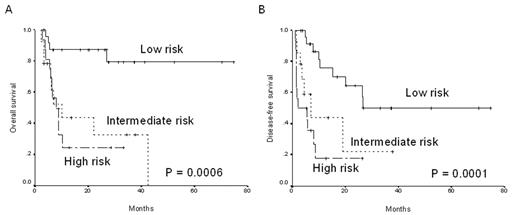Abstract
Ki-67 is a nuclear antigen expressed by dividing cells, therefore, the percentage of Ki-67-positive cells reflects the proportion of tumor cells actively proliferating. However, the prognostic value of Ki-67 expression is still controversial in non-Hodgkin’s lymphoma. Although a recent study in peripheral T-cell lymphoma showed a positive correlation with poor prognosis, the prognostic value of Ki-67 has never been studied in patients with extranodal NK/T cell lymphoma. Therefore, we performed this study to determine the value of Ki-67 expression in predicting prognosis and to propose a new prognostic model involving Ki-67 expression in patients with extranodal NK/T cell lymphoma. We studied 65 patients who were diagnosed with extranodal NK/T cell lymphoma from 1999 to 2005. All patients were treated with combination chemotherapy alone or followed by radiotherapy. We analyzed the percentage of Ki-67 expressing cells and determined its prognostic significance in terms of overall survival (OS) and disease-free survival (DFS). The immunohistochemical staining of Ki-67 was available for this study in fifty-five patients. The median age was 41 (range: 19 – 74 years), 89.1 percent of the patients (49/55) had an ambulatory performance status: Eastern Cooperative Oncology Group (ECOG) 0–1. Fifty-one patients presented as a localized disease: Ann Arbor stage I or II, and elevated level of serum lactate dehydrogenase (LDH) was observed in 14 patients. Thus, most patients showed the low or low-intermediate international prognostic index (IPI): low risk (74.5%, 41/55) or low intermediate risk (18.2%, 10/55). The percentage of Ki-67 expressing tumor cells was ranged from 5% to 95%, and the patients were separated into two groups: low Ki-67 (< 50%) versus high (≥ 50%). The patients in the high Ki-67 group had a shorter OS (95% CI 1.0-6.3, P = 0.046) and DFS (95% CI 1.1-5.5, P = 0.024) while the IPI failed to predict worse OS. Ki-67 expression could also predict the group with worse prognosis in 51 patients of low and low-intermediate IPI risk. Age, serum LDH, B symptoms, and tumor size were also associated with worse OS or DFS. Thus, based on the univariate and mutivariate analysis, we proposed a new prognostic index (KLABS index) with high Ki-67 expression, increased serum LDH, Age (≥ 60 years), presence of B symptoms, and bulky Size of tumors (≥ 10cm2) as follows: low risk, none or one of the above-mentioned factors; intermediate risk, presence of two factors; high risk, presence of three or more factors. This new index showed a high degree of correlation with survival outcomes in terms of OS and DFS (Figure A, B). This study demonstrated the prognostic significance of Ki-67 expression, and our new prognostic index may become a useful tool for predicting prognosis in extranodal NK/T cell lymphoma, nasal type.
Disclosure: No relevant conflicts of interest to declare.
Author notes
Corresponding author


